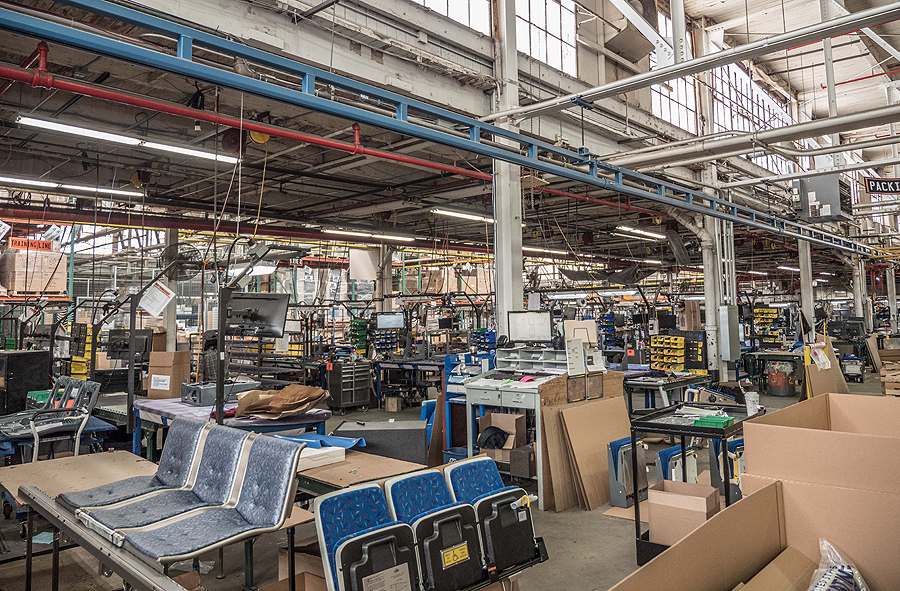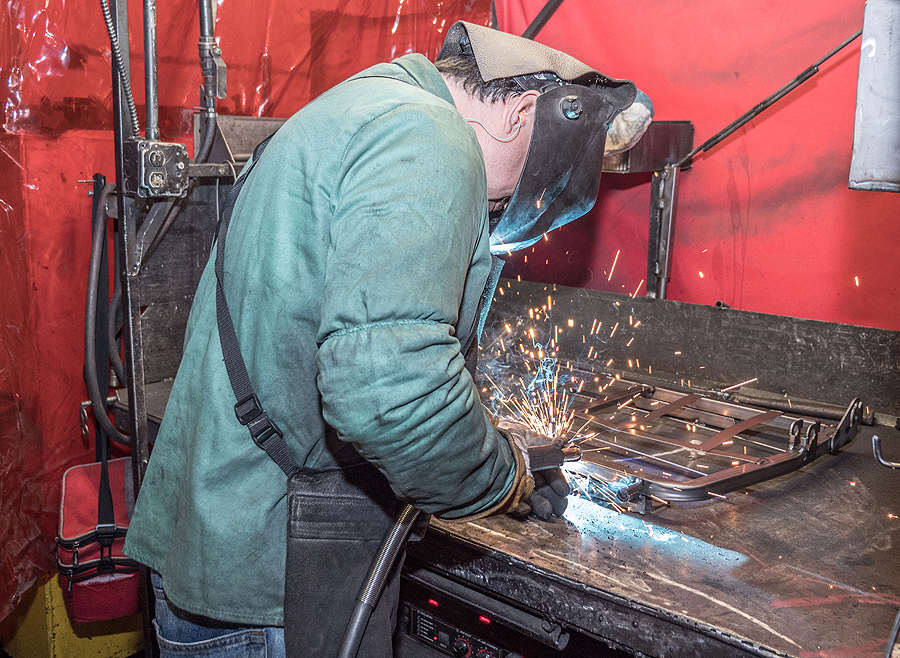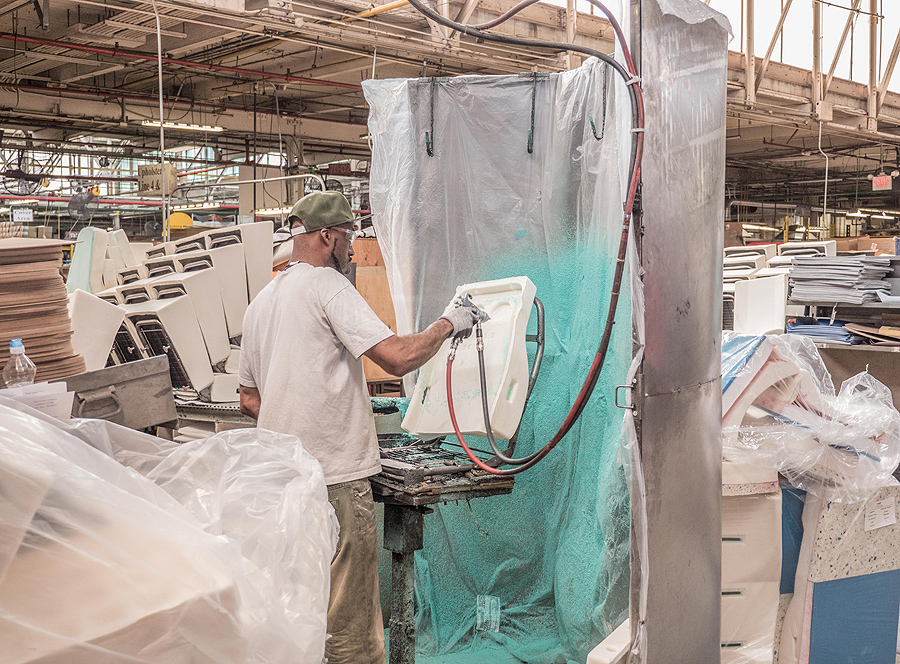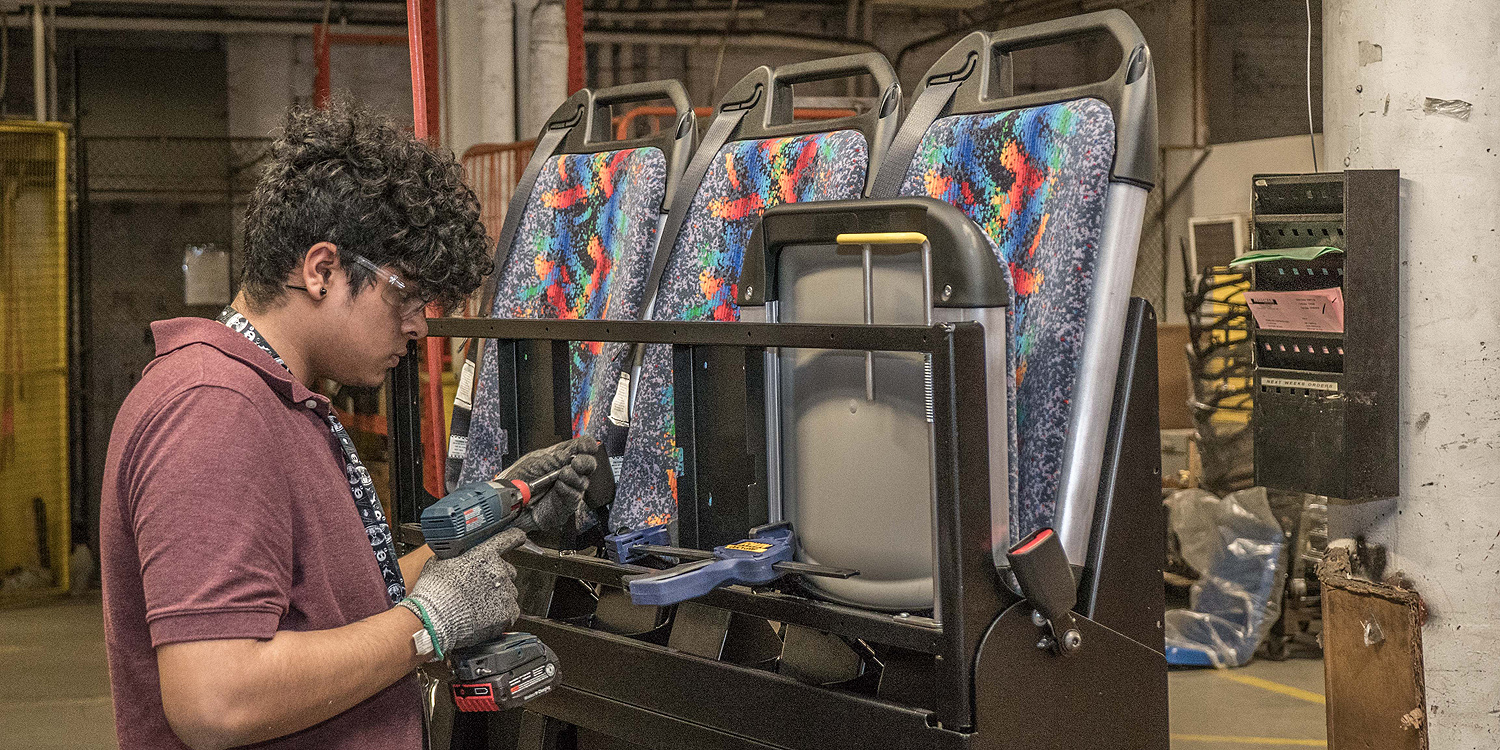The forest of steel rods and blowtorch sparks make it hard to tell at first what’s being built at Freedman Seating’s 400,000 square-foot headquarters in West Humboldt Park, but the rainbow-burst patterns on the racks of fabric swatches are unmistakable.
“Every authority wants their own mark,” CEO Craig Freedman says as he walks the factory floor. “The CTA and Pace have their own styles, and some hire outside designers. With computerized looms, you can pretty much get anything you want these days.”
A lot’s changed since the old days, Freedman says.
He peers through the window of a space capsule-looking tube, where a robotic arm is zapping lasers into a rotating steel plate. For an operation pumping out dozens of unique models every day, assembly line workers drilling holes no longer do the trick, says.
If you’ve ever nabbed an open seat on a public bus in this country, the odds are decent that the hardware you sat on began its life in this single frenzied warehouse. Freedman Seating has contracts with about 80 percent of transit agencies in the United States, customizing seats for buses, subway trains, airport trams and paratransit vans from coast to coast.

A quick sweep of the seating catalog on Freedman’s website shows the range of what they offer. There’s the Sophia, a lightly-padded chair designed for commuter trains. Charter bus operators may prefer the Feather Weight Hi-Back, whose wide cushions maximize leg room.
Since 2009, CTA has been buying the Gemini model—a minimalist polyurethane shell with a curved back for lumbar support—for almost 500 buses, according to agency spokesman Stephen Mayberry.
When shopping for seats, transit agencies have to walk a fine line between “innovative seat design, which reduces vehicle weight and fuel costs for CTA,” and “a level of durability that withstands heavy-duty use,” Mayberry said.
There are other considerations, too, like the evolving debate over whether it’s worthwhile to stitch fabric onto seats used by short-trip riders.
The CTA uses a specific grade of fabric on its buses, a graffiti- and cutting-resistant material called Holdsworth Vr50, Mayberry said.
But the wider industry is trending toward hardshell plastic seats to keep riders from having to ponder the origins of mysterious dark splotches, according to Freedman.

“Fabric seats are harder to clean. So some people like the feel of it, but others just don’t like to think about what else could be on that seat,“ Freedman said. “Vinyl is becoming more and more in demand, so much so that fabric manufacturers are consolidating. Demand is really dropping off.”
The quality of Freedman Seating’s upholstery was its foothold in the seating industry 125 years ago, when Freedman’s great grandfather earned honorable mention at the 1893 Columbian Exposition for the fabric he stitched onto the seats of horse-drawn carriages.
The family shifted seamlessly into designing seats for automobiles, and by the 1940s they had carved out a niche designing seats for the cabs of delivery trucks. From there, they were well-positioned to capitalize on a late-20th Century bus manufacturing boom, as airports, hotels and car rental agencies commissioned shuttles to carry customers over widening concrete streetscapes.
But it was a law, not an innovation, that blew open the company’s biggest opportunity to date.
The 1990 passage of the Americans with Disabilites Act forced transit agencies rethink their vehicle designs from the bottom up, lowering bus floors so that passengers in wheelchairs could safely roll into their daily commutes.
Seats had to be built around the new design challenges, necessitating manufacturers like Freedman to “make snowflakes on a daily basis, at a relatively high volume,” the CEO said.
“To the untrained eye, you don’t realize that a modern bus with 38 different seating places has about 25 unique chair designs,” Freedman said. “There are components that flip, fold, have to fit over a wheel well or a heating duct. So suddenly a serialized business has turned into a totally customized industry.”

When Freedman Seating proved up to the task, hundreds of public and private transit operators lined up for their business. The awkward shape of transit seats makes them inconvenient to ship overseas, inoculating Freedman from the 1990s trade agreements that pushed other manufacturers out of town en masse.
The company outgrew its three-story headquarters in Ravenswood and made for a campus in West Humboldt Park that been built and operated by Motorola. Freedman bought up a next-door parcel in 2015 for a 110,000 square-foot expansion, but even that may not be enough, he said.
On the factory floor, the CEO darted from station to station on the sprawling factory floor, checking to see that each function is being fulfilled, whether by humans or robots.
“We have so much demand right now, I need every one of these machines to be operating 30 hours a day,” Freedman said.
If automation is snatching jobs from wage workers, no one told Freedman’s 900 employees. The space is a blur of machine operators, tailors and forklift drivers. Near the front office, conference rooms are full of mid-level managers. A company gym is holding a Crossfit class.
The boss says he’s still trying to hire as many workers as he can get—preferably from the factory’s surrounding neighborhood—to help build out an industry whose demands get thornier every year.
One of their newest challenges is building power outlets and USB ports, suddenly an expectation for commuters, into new lines of seats.
“Every bus manufacturer has a different electrical configuration, so we have to do something special to accommodate every one of them,” Freedman said. “But I really shouldn’t complain, because that’s the reason why we’re in business in the first place.”



